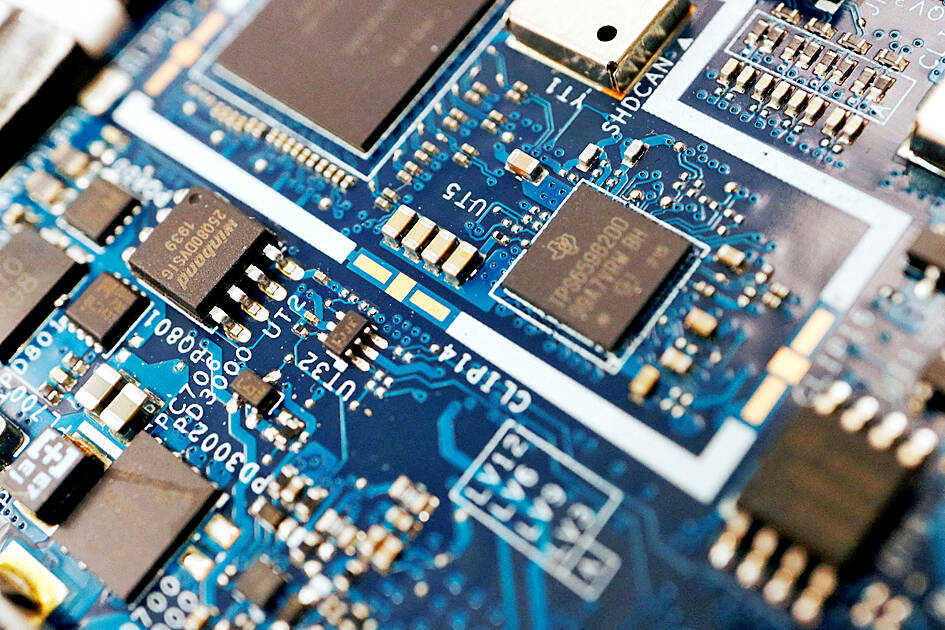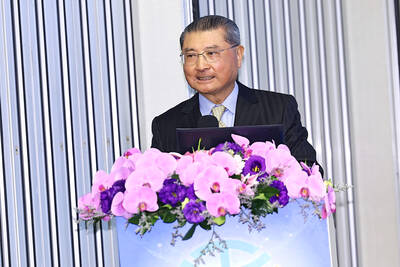Taiwan is forecast to retain its position as having the second-largest semiconductor capacity in the world this year, with production capacity set to increase more than 4 percent from a year earlier, the global semiconductor trade association SEMI said on Thursday.
The global semiconductor industry is expected to enjoy a recovery in demand after a slump last year, as many countries are coming up with incentives to encourage production expansion by building new wafer foundry plants and introducing new equipment, SEMI global chief marketing officer and Taiwan president Terry Tsao (曹世綸) said in a statement.
SEMI’s latest World Fab Forecast report said global semiconductor capacity is expected to rise 6.4 percent this year and surpass 30 million wafers per month to a new high after rising 5.5 percent to 29.6 wafers per month last year.

Photo: Reuters
This year, 42 new semiconductor fabs are to start mass production, compared with 11 last year, it said.
“Resurgent market demand and increased government incentives worldwide are powering an upsurge in fab investments in key chipmaking regions and the projected 6.4 percent rise in global capacity for 2024,” SEMI president and CEO Ajit Manocha said in the report.
“The heightened global attention on the strategic importance of semiconductor manufacturing to national and economic security is a key catalyst of the trend,” Manocha added.
Taiwan’s output is expected to reach 5.7 million wafers per month this year, up 4.2 percent from a year earlier after an anticipated year-on-year increase of 5.6 percent last year, which pushed it to 5.4 million wafers per month, the report said.
China is expected to raise its capacity to 8.6 million units per month this year, up 13 percent from a year earlier, to take the top spot in the world on the back of government funding and other incentives, the report said.
Chinese semiconductor suppliers are projected to add 18 wafer fabs this year, SEMI said.
South Korea’s capacity is expected to rise 5.4 percent from a year earlier to 5.10 million wafers per month, giving it the third-largest capacity in the world, the report said.
Japan is expected to boost its output by about 2 percent from a year earlier to 4.70 million units per month, taking the No. 4 spot, it added.
In the Americas, semiconductor capacity is expected to grow 6 percent from a year earlier to 3.10 million wafers per month, while capacity in Europe and the Middle East is to rise 3.6 percent to 2.70 million units per month and capacity in Southeast Asia is forecast to rise 4 percent to 1.70 million units per month, it said.
The pure wafer foundry segment is expected to become the largest buyer of production equipment for its expansion, with capacity likely to hit 10.20 million wafers per month, up from the anticipated 9.3 million last year, SEMI said.
As for the memorychip segment, DRAM suppliers are expected to raise capacity by 2 percent to 3.8 million wafers per month and an additional 5 percent to 4 million units per month next year, it said.

When an apartment comes up for rent in Germany’s big cities, hundreds of prospective tenants often queue down the street to view it, but the acute shortage of affordable housing is getting scant attention ahead of today’s snap general election. “Housing is one of the main problems for people, but nobody talks about it, nobody takes it seriously,” said Andreas Ibel, president of Build Europe, an association representing housing developers. Migration and the sluggish economy top the list of voters’ concerns, but analysts say housing policy fails to break through as returns on investment take time to register, making the

‘SILVER LINING’: Although the news caused TSMC to fall on the local market, an analyst said that as tariffs are not set to go into effect until April, there is still time for negotiations US President Donald Trump on Tuesday said that he would likely impose tariffs on semiconductor, automobile and pharmaceutical imports of about 25 percent, with an announcement coming as soon as April 2 in a move that would represent a dramatic widening of the US leader’s trade war. “I probably will tell you that on April 2, but it’ll be in the neighborhood of 25 percent,” Trump told reporters at his Mar-a-Lago club when asked about his plan for auto tariffs. Asked about similar levies on pharmaceutical drugs and semiconductors, the president said that “it’ll be 25 percent and higher, and it’ll

CHIP BOOM: Revenue for the semiconductor industry is set to reach US$1 trillion by 2032, opening up opportunities for the chip pacakging and testing company, it said ASE Technology Holding Co (日月光投控), the world’s largest provider of outsourced semiconductor assembly and test (OSAT) services, yesterday launched a new advanced manufacturing facility in Penang, Malaysia, aiming to meet growing demand for emerging technologies such as generative artificial intelligence (AI) applications. The US$300 million facility is a critical step in expanding ASE’s global footprint, offering an alternative for customers from the US, Europe, Japan, South Korea and China to assemble and test chips outside of Taiwan amid efforts to diversify supply chains. The plant, the company’s fifth in Malaysia, is part of a strategic expansion plan that would more than triple

Taiwanese artificial intelligence (AI) server makers are expected to make major investments in Texas in May after US President Donald Trump’s first 100 days in office and amid his rising tariff threats, Taiwan Electrical and Electronic Manufacturers’ Association (TEEMA, 台灣電子電機公會) chairman Richard Lee (李詩欽) said yesterday. The association led a delegation of seven AI server manufacturers to Washington, as well as the US states of California, Texas and New Mexico, to discuss land and tax issues, as Taiwanese firms speed up their production plans in the US with many of them seeing Texas as their top option for investment, Lee said. The